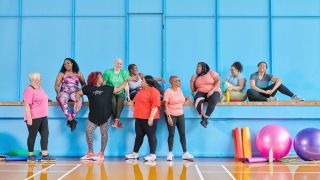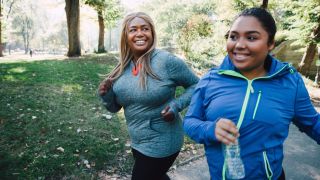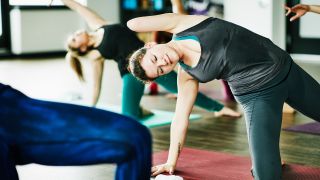The Best Types Of Workouts For Women And When To Do Them
Experts explain how you can reap the benefits of doing the right workouts at the right time for your body

The best type of exercise for anyone is the one you enjoy doing and will keep doing. That’s because exercise not only provides endless benefits to our physical health, but can also help with our mental health.
While both men and women can reap these benefits, there are some types of workouts that women may benefit from more. If you’re looking to become more active or try something new, this kind of information can help you decide from all the different ways there are to get fit.
Certain exercises and workouts can also help with pregnancy and labour, as well as making life a little easier after the baby is born. In addition, certain types of workouts can be better suited to different stages of the menstrual cycle.
We spoke to experts with experience of training women to find out which are the best workouts for women and when is best to do them.
Strength Training

This is the big one for women. Incorporating weights into your workout is important for a number of reasons. According to Sarah Lindsay, founder of and master trainer at ROAR Fitness, raising metabolism, improving posture, increasing muscle and boosting physical confidence are just a few of the advantages to weight training.
“But for me, being strong and physically capable trumps them all,” says Lindsay. “Overloading the muscle progressively is the only way to keep getting stronger and that’s done by increasing the amount of weight, time the muscles are under tension, repetitions, sets or overall workout volume.
“Make sure you are increasing the number of reps at the current weight you’re lifting, with the long-term goal of achieving the same number of reps with a heavier weight. The stronger you are, the easier every physical demand in life is. Being physically strong and capable gives you confidence in other areas of life.”
Get the Coach Newsletter
Sign up for workout ideas, training advice, reviews of the latest gear and more.
Women have a greater amount of slow-twitch muscle fibres than men
Women may also want to strength train slightly differently from men, too. Jess Rosart, gym manager at WIT Fitness, explains that women have a greater amount of slow-twitch muscle fibres than men. “We should train these types of muscle fibres more to reach our full potential,” says Rosart.
Slow-twitch muscle fibres can withstand being used for far longer than fast-twitch muscle fibres, which tire more quickly. Because women have more slow-twitch muscle fibres, more reps per set can be beneficial for women, according to Rosart. Additionally, she says, “women tend to need less rest between sets but they do not need more rest days than men”.
Another big benefit of strength training for women is that it helps increase bone density. During and after the menopause, hormonal changes can cause women’s bones to weaken, putting them at a higher risk of osteoporosis. However, resistance training can help counteract this.
So how often should women strength train? As with most things, the amount will vary from person to person. “Weight training three to four times per week is generally optimal,” says Lindsay, “but some people do need more recovery. If you’re struggling to recover from training then you need more rest, food and sleep.”
“Although exercise is key, rest is just as important,” says Rosart. “Rest days allow your muscles to repair and rebuild, plus they help you avoid mental burn-out and reduce your risk of injury. If you want to see results from your training, rest days are essential.”
- Train with confidence using this beginner gym workout plan for women
- The ultimate arm workout for women
- Great glute workouts for women of all levels – from beginner to gym pro
Cardio (At The Right Time)

Running, cycling, swimming and rowing are the most popular cardio-based exercises. Although there isn’t a cardio workout that is more suited to women, choosing to do cardio or endurance-based exercises at certain times of your cycle can be helpful.
For women, cardio workouts are better suited to the week after a period as well as around ovulation (mid-cycle), when energy levels are higher.
In the week leading up to your period and during the period itself, hormone fluctuations can cause fatigue to kick in, making cardio and endurance workouts feel a lot harder.
Personal trainer Aimee Victoria Long adds that the big benefit of cardio is that it gets your heart and lungs working hard, which helps maintain a healthy cardiovascular system. Doing cardio will also help increase your calorie burn.
“‘If you’re looking to lose weight, the more calories you burn the better,” says Long. “If you’re aiming to be in calorie deficit, performing cardio workouts allow you to build up a bigger deficit as long as you’re not eating more calories than you’re burning.’”
She adds that HIIT training can be a great way to get in a good workout when time is against you. “Interval training involves working at higher intensities for short periods.”
Yoga

Yoga instructor Molly Robinson says that yoga is an ideal activity to do during your period and the week before, when energy levels are flagging and a calmer workout might be welcome.
“Yoga connects the mind and body, helping us to focus on our breathing, to reduce stress and encourage relaxation,” explains Robinson, who adds that flexibility also improves by practising yoga regularly.
Flexibility is essential to reduce the likelihood of injuries as well as to help us with everyday tasks.
Pregnancy yoga can be helpful since it can help reduce lower-back pain – a common issue for pregnant women – while also increasing strength. In addition, because it’s calming and allows the body to relax, it can also help to ease headaches and nausea.

Lucy is an experienced health and fitness journalist, and was formerly health editor for TI Media’s portfolio of women’s titles. Lucy qualified as a level 3 personal trainer with Train Fitness in 2016, and also holds qualifications in pre- and post-natal fitness, as well as in nutrition for exercise.
